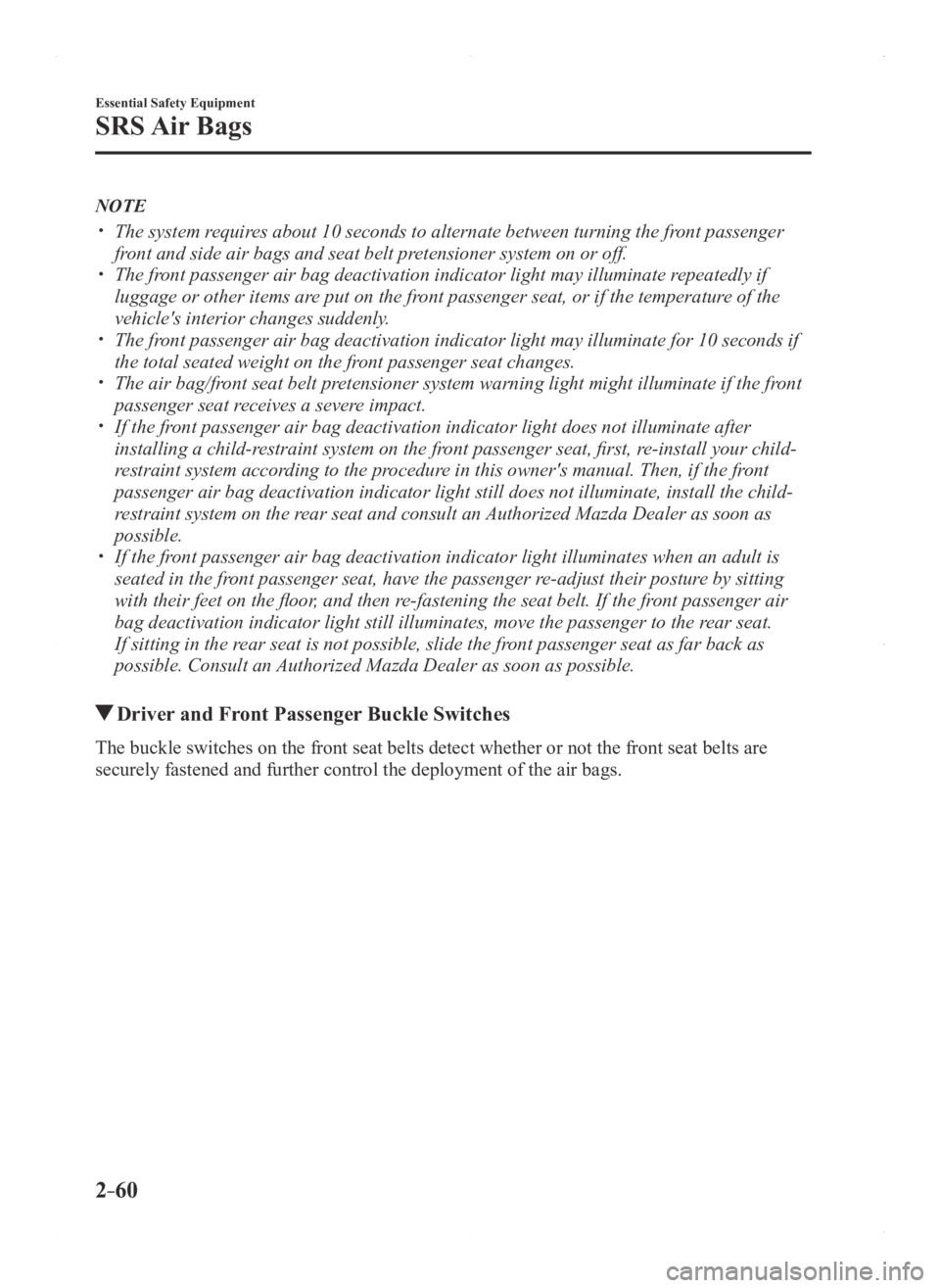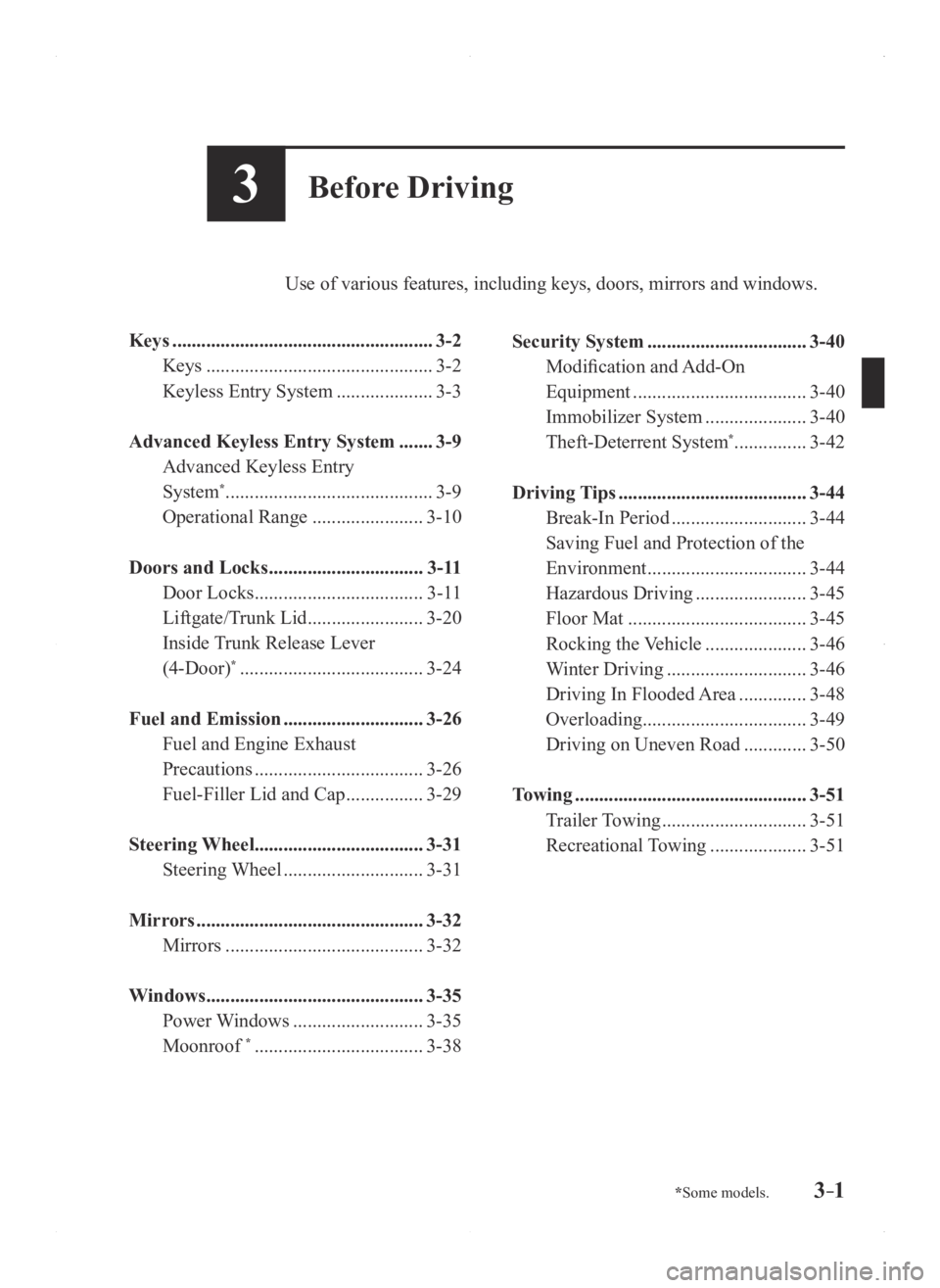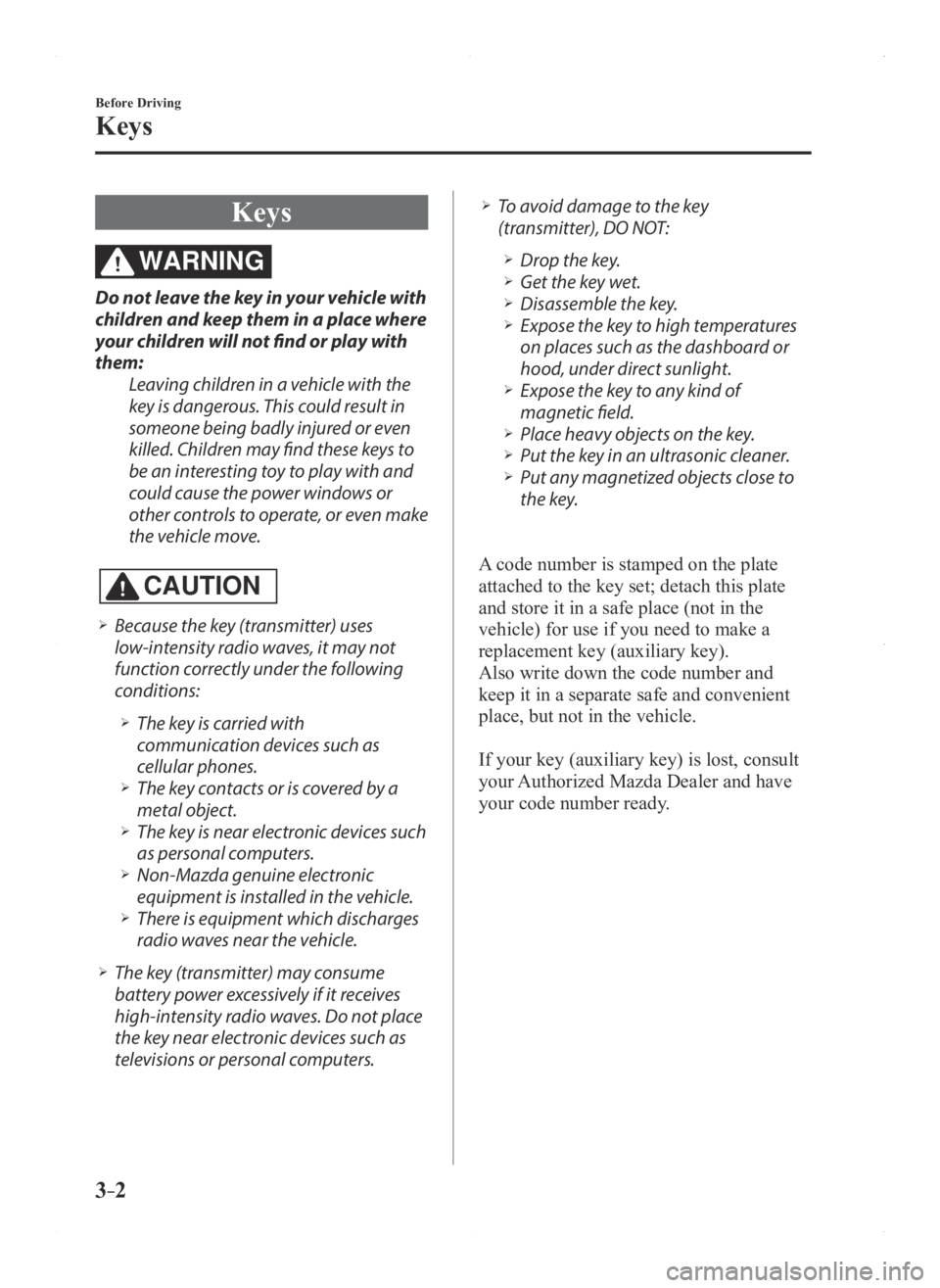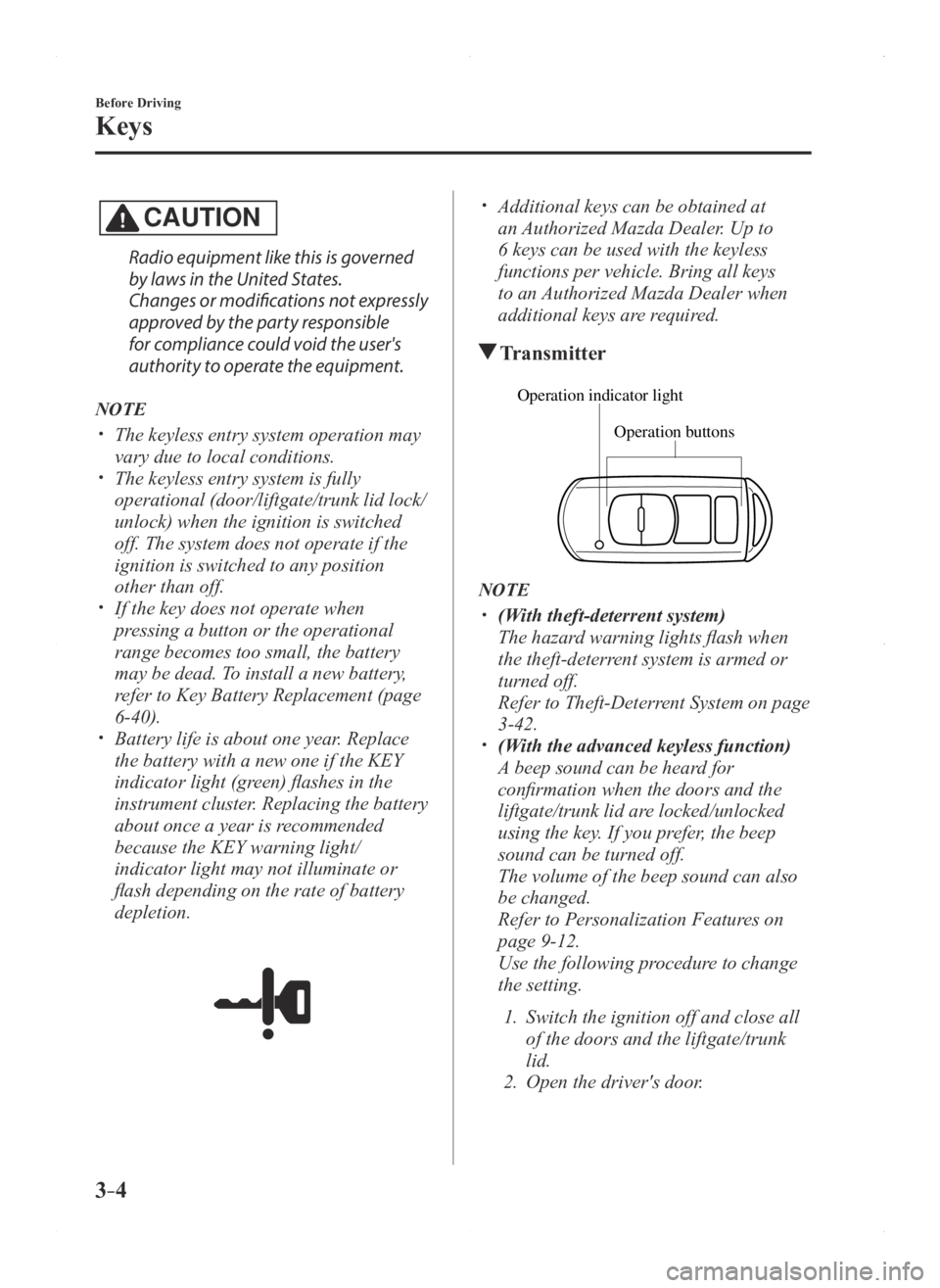MAZDA MODEL 3 5-DOOR 2016 Manual PDF
Manufacturer: MAZDA, Model Year: 2016, Model line: MODEL 3 5-DOOR, Model: MAZDA MODEL 3 5-DOOR 2016Pages: 598, PDF Size: 30.13 MB
Page 71 of 598

2–57
Essential Safety Equipment
SRS Air Bags
Front passenger air bag deactivation indicator light on/off condition chart
Condition detected by the front passenger
occupant classification system Front passenger air bag
deactivation indicator light Front passenger front
and side air bags Front passenger seat
belt pretensioner system
Empty (Not occupied) OnDeactivated Deactivated
Child or child-restraint
system
*1On Deactivated Deactivated
Adult
*2Off ReadyReady
*1 If a larger child sits on the front passenger seat, the sensors might detect the\
child as being an adult depending on the child's physique.*2 If a smaller adult sits on the front passenger seat, the sensors might d\
etect the person as being a child depending on the person's physique.
The curtain air bag is ready for inflating regardless of what the front passenger air bag
deactivation indicator light on/off condition chart indicates.
If the front passenger air bag deactivation indicator light does not ill\
uminate when the
ignition is switched ON and does not illuminate as indicated in the front passenger air bag
deactivation indicator light on/off condition chart, do not allow a child to sit in the front
passenger seat and consult an Authorized Mazda Dealer as soon as possible. The system
may not work properly in an accident.
Mazda3_8FA4-EA-15G_Edition1.indb 572015/05/11 14:00:16
Page 72 of 598

2–58
Essential Safety Equipment
SRS Air Bags
WARNING
Do not decrease the total seated weight on the front passenger seat:
When an adult or large child sits on the front passenger seat, decreasing the total seated
weight on the front passenger seat required for air bag deployment is dangerous. The
front passenger seat weight sensors will detect the reduced total seated weight condition
and the front passenger front and side air bags and seat belt pretensioner system will
not deploy during an accident. The front passenger will not have the supplementary
protection of the air bag, which could result in serious injury. Decreasing the total seated
weight on the front passenger seat could result in an air bag not deploying under the
following conditions, for example:
A front passenger is seated as shown in the following figure:
A rear passenger pushes up on the front passenger seat with their feet. Luggage or other items placed under the front passenger seat or between the front
passenger seat and driver seat that push up the front passenger seat bottom. Any accessories which might decrease the total seated weight on the front passenger
seat are attached to the front passenger seat.
The front passenger front and side air bags and seat belt pretensioner systems will
deactivate if the front passenger air bag deactivation indicator light illuminates.
Mazda3_8FA4-EA-15G_Edition1.indb 582015/05/11 14:00:16
Page 73 of 598

2–59
Essential Safety Equipment
SRS Air Bags
Do not increase the total seated weight on the front passenger seat:When an infant or small child sits on the front passenger seat, increasing the total seated
weight on the front passenger seat is dangerous. The front passenger seat weight sensors
will detect the increased total seated weight, which could result in the unexpected
deployment of the front passenger front and side air bags and seat belt pretensioner
system in an accident and may cause serious injury. Increasing the total seated weight on
the front passenger seat could result in the front passenger front and side air bags and
seat belt pretensioner system deployment in an accident under the following conditions,
for example:
Luggage or other items are placed on the seat with the child in the child-restraint
system. A rear passenger or luggage push or pull down on the front passenger seatback. A rear passenger steps on the front passenger seat rails with their feet. Luggage or other items are placed on the seatback or hung on the head restraint. Heavy items are placed in the seatback map pocket. The seat is washed. Liquids are spilled on the seat. The front passenger seat is moved backward, pushing into luggage or other items
placed behind it. The front passenger seatback contacts the rear seat. Luggage or other items are placed between the front passenger seat and driver seat. Any accessories which might increase the total seated weight on the front passenger
seat are attached to the front passenger seat.
CAUTION
To assure proper deployment of the front air bag and to prevent damage to the sensors in
the front seat bottoms:
Do not place sharp objects on the front seat bottoms or leave heavy luggage on them. Do not spill any liquids on the front seats or under the front seats.
To allow the sensors to function properly, always perform the following:
Adjust the front seats as far back as possible and always sit upright against the
seatbacks with seat belts worn properly. If you place your child on the front passenger seat, secure the child-restraint system
properly and slide the front passenger seat as far back as possible (page 2-30).
Mazda3_8FA4-EA-15G_Edition1.indb 592015/05/11 14:00:16
Page 74 of 598

2–60
Essential Safety Equipment
SRS Air Bags
NOTE
The system requires about 10 seconds to alternate between turning the front passenger
front and side air bags and seat belt pretensioner system on or off. The front passenger air bag deactivation indicator light may illuminate repeatedly if
luggage or other items are put on the front passenger seat, or if the temperature of the
vehicle's interior changes suddenly.
The front passenger air bag deactivation indicator light may illuminate for 10\
seconds if
the total seated weight on the front passenger seat changes. The air bag/fr ont seat belt pretensioner system warning light might illuminate if the front
passenger seat receives a severe impact. If the front passenger air bag deactivation indicator light does not illuminate a\
fter
installing a child-restraint system on the front passenger seat, first, re-install your child-
restraint system according to the procedure in this owner's manual. Then, if the front
passenger air bag deactivation indicator light still does not illuminate\
, install the child-
restraint system on the rear seat and consult an Authorized Mazda Dealer as soon as
possible.
If the front passenger air bag deactivation indicator light illuminates when an a\
dult is
seated in the front passenger seat, have the passenger re-adjust their posture by sitting
with their feet on the floor, and then re-fastening the seat belt. If the front passenger air
bag deactivation indicator light still illuminates, move the passenger t\
o the rear seat.
If sitting in the rear seat is not possible, slide the front passenger seat as far back as
possible. Consult an Authorized Mazda Dealer as soon as possible.
Driver and Front Passenger Buckle Switches
The buckle switches on the front seat belts detect whether or not the fr\
ont seat belts are
securely fastened and further control the deployment of the air bags.
Mazda3_8FA4-EA-15G_Edition1.indb 602015/05/11 14:00:16
Page 75 of 598

2–61
Essential Safety Equipment
SRS Air Bags
Constant Monitoring
The following components of the air bag systems are monitored by a diagn\
ostic system:
Crash sensors, and diagnostic module (SAS unit) Front air bag sensors Air bag modules Side crash sensors Air bag/Front seat belt pretensioner system warning light Front seat belt pretensioners Related wiring
(With Front Passenger Occupant Classification System)
Front passenger air bag deactivation indicator light Front passenger seat weight sensors Front passenger seat weight sensor control module Front passenger seat belt buckle switches
The diagnostic module continuously monitors the system's readiness. This begins when the
ignition is switched ON and continues while the vehicle is being driven.
Mazda3_8FA4-EA-15G_Edition1.indb 612015/05/11 14:00:16
Page 76 of 598

2–62
Mazda3_8FA4-EA-15G_Edition1.indb 622015/05/11 14:00:16
MEMO
Page 77 of 598

3–1*Some models.
3Before Driving
Use of various features, including keys, doors, mirrors and windows.
Keys ......................................................3-2
Keys
...............................................3-2
Keyless Entry System
....................3-3
Advanced Keyless Entry System
.......3-9
Advanced Keyless Entry
System
* ...........................................3-9
Operational Range
.......................3-10
Doors and Locks
................................3-11
Door Locks
...................................3-11
Liftgate/Trunk Lid
........................3-20
Inside Trunk Release Lever
(4-Door)
* ......................................3-24
Fuel and Emission
.............................3-26
Fuel and Engine Exhaust
Precautions
...................................3-26
Fuel-Filler Lid and Cap
................3-29
Steering Wheel ................................... 3-31
Steering Wheel
.............................3-31
Mirrors
...............................................3-32
Mirrors
.........................................3-32
Windows
.............................................3-35
Power Windows
...........................3-35
Moonroof * ...................................3-38 Security System
.................................3-40
Modification and Add-On
Equipment
....................................3-40
Immobilizer System
.....................3-40
Theft-Deterrent System* ...............3-42
Driving Tips
.......................................3-44
Break-In Period
............................3-44
Saving Fuel and Protection of the
Environment
.................................3-44
Hazardous Driving
.......................3-45
Floor Mat
.....................................3-45
Rocking the Vehicle
.....................3-46
Winter Driving
.............................3-46
Driving In Flooded Area
..............3-48
Overloading
..................................3-49
Driving on Uneven Road
.............3-50
Towing
................................................3-51
Trailer Towing
..............................3-51
Recreational Towing
....................3-51
Mazda3_8FA4-EA-15G_Edition1.indb 12015/05/11 14:00:16
Page 78 of 598

3–2
Before Driving
Keys
Keys
WARNING
Do not leave the key in your vehicle with
children and keep them in a place where
your children will not find or play with
them:Leaving children in a vehicle with the
key is dangerous. This could result in
someone being badly injured or even
killed. Children may find these keys to
be an interesting toy to play with and
could cause the power windows or
other controls to operate, or even make
the vehicle move.
CAUTION
Because the key (transmitter) uses
low-intensity radio waves, it may not
function correctly under the following
conditions:
The key is carried with
communication devices such as
cellular phones.
The key contacts or is covered by a
metal object. The key is near electronic devices such
as personal computers. Non-Mazda genuine electronic
equipment is installed in the vehicle. There is equipment which discharges
radio waves near the vehicle.
The key (transmitter) may consume
battery power excessively if it receives
high-intensity radio waves. Do not place
the key near electronic devices such as
televisions or personal computers.
To avoid damage to the key
(transmitter), DO NOT:
Drop the key. Get the key wet. Disassemble the key. Expose the key to high temperatures
on places such as the dashboard or
hood, under direct sunlight.
Expose the key to any kind of
magnetic field. Place heavy objects on the key. Put the key in an ultrasonic cleaner. Put any magnetized objects close to
the key.
A code number is stamped on the plate
attached to the key set; detach this plate
and store it in a safe place (not in the
vehicle) for use if you need to make a
replacement key (auxiliary key).
Also write down the code number and
keep it in a separate safe and convenient
place, but not in the vehicle.
If your key (auxiliary key) is lost, consult
your Authorized Mazda Dealer and have
your code number ready.
Mazda3_8FA4-EA-15G_Edition1.indb 22015/05/11 14:00:17
Page 79 of 598

3–3
Before Driving
Keys
NOTE
The driver must carry the key to ensure the
system functions properly.
Auxiliary key
Transmitter
Ke y code number plate
To use the auxiliary key, press the knob
and pull out the auxiliary key from the
transmitter.
Keyless Entry System
This system uses the key buttons to
remotely lock and unlock the doors and
the liftgate/trunk lid, and opens the trunk
lid.
The system can start the engine without
having to take the key out of your purse or
pocket.
It can also help you signal for attention.
Operating the theft-deterrent system is
also possible on theft-deterrent system-
equipped vehicles.
Press the buttons slowly and carefully.
System malfunctions or warnings are
indicated by the following warning lights
or beeps.
KEY Warning Light (Red)
Refer to Warning/Indicator Lights on
page 4-20. Ignition Not Switched Of f (STOP)
Warning Beep
Refer to Ignition Not Switched Of f
(STOP) Warning Beep on page 7-36. Key Removed from Vehicle Warning
Beep
Refer to Key Removed from Vehicle
Warning Beep on page 7-36.
If you have a problem with the key,
consult an Authorized Mazda Dealer.
If your key is lost or stolen, consult an
Authorized Mazda Dealer as soon as
possible for a replacement and to make the
lost or stolen key inoperative.
Mazda3_8FA4-EA-15G_Edition3.indb 32015/12/04 19:22:07
Page 80 of 598

3–4
Before Driving
Keys
CAUTION
Radio equipment like this is governed
by laws in the United States.
Changes or modifications not expressly
approved by the party responsible
for compliance could void the user's
authority to operate the equipment.
NOTE
The keyless entry system operation may
vary due to local conditions. The keyless entry system is fully
operational (door/liftgate/trunk lid lock/
unlock) when the ignition is switched
off. The system does not operate if the
ignition is switched to any position
other than off.
If the key does not operate when
pressing a button or the operational
range becomes too small, the battery
may be dead. To install a new battery,
refer to Key Battery Replacement (page
6-40).
Battery life is about one year. Replace
the battery with a new one if the KEY
indicator light (green) flashes in the
instrument cluster. Replacing the battery
about once a year is recommended
because the KEY warning light/
indicator light may not illuminate or
flash depending on the rate of battery
depletion.
Additional keys can be obtained at
an Authorized Mazda Dealer. Up to
6 keys can be used with the keyless
functions per vehicle. Bring all keys
to an Authorized Mazda Dealer when
additional keys are required.
Transmitter
Operation buttons
Operation indicator light
NOTE
(With theft-deterrent system)
The hazard warning lights flash when
the theft-deterrent system is armed or
turned off.
Refer to Theft-Deterrent System on page
3-42. (With the advanced keyless function)
A beep sound can be heard for
confirmation when the doors and the
liftgate/trunk lid are locked/unlocked
using the key. If you prefer, the beep
sound can be turned off.
The volume of the beep sound can also
be changed.
Refer to Personalization Featur es on
page 9-12.
Use the following procedure to change
the setting.
1. Switch the ignition off and close all
of the doors and the liftgate/trunk
lid.
2. Open the driver's door .
Mazda3_8FA4-EA-15G_Edition1.indb 42015/05/11 14:00:17